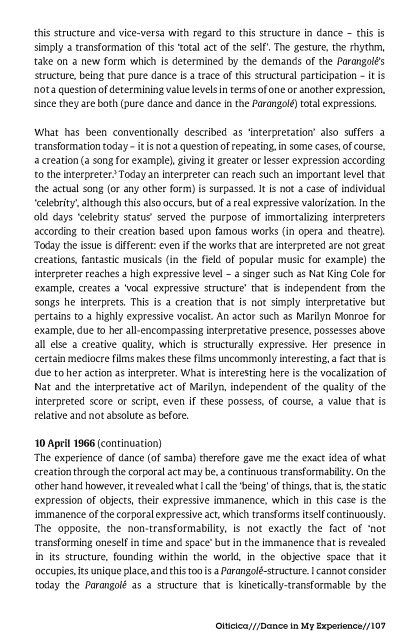Create successful ePaper yourself
Turn your PDF publications into a flip-book with our unique Google optimized e-Paper software.
this structure and vice-versa with regard to this structure in dance - this is<br />
simply a transformation of this 'total act of the self'. The gesture, the rhythm,<br />
take on a new form which is determined by the demands of the Parango/e's<br />
structure, being that pure dance is a trace of this structural participation - it is<br />
not a question of determining value levels in terms of one or another expression,<br />
since they are both (pure dance and dance in the Parangol£') total expressions.<br />
What has been conventionally described as 'interpretation' also suffers a<br />
transformation today - it is not a question of repeating, in some cases, of course,<br />
a creation (a song for example), giving it greater or lesser expression according<br />
to the interpreter.' Today an interpreter can reach such an important level that<br />
the actual song (or any other form) is surpassed. It is not a case of individual<br />
'celebrity', although this also occurs, but of a real expressive valorization. In the<br />
old days 'celebrity status' served the purpose of immortalizing interpreters<br />
according to their creation based upon famous works (in opera and theatre).<br />
Today the issue is different: even if the works that are interpreted are not great<br />
creations, fantastic musicals (in the field of popular music for example) the<br />
interpreter reaches a high expressive level - a singer such as Nat King Cole for<br />
example, creates a 'vocal expressive structure' that is independent from the<br />
songs he interprets. This is a creation that is not simply interpretative but<br />
pertains to a highly expressive vocalist. An actor such as Marilyn Monroe for<br />
example, due to her all-encompassing interpretative presence, possesses above<br />
all else a creative quality, which is structurally expressive. Her presence in<br />
certain mediocre films makes these films uncommonly interesting, a fact that is<br />
due to her action as interpreter. What is intereSting here is the vocalization of<br />
Nat and the interpretative act of Marilyn, independent of the quality of the<br />
interpreted score or script, even if these possess, of course, a value that is<br />
relative and not absolute as before.<br />
10 April 1966 (continuation)<br />
The experience of dance (of samba) therefore gave me the exact idea of what<br />
creation through the corporal act may be, a continuous transformability. On the<br />
other hand however, it revealed what I call the 'being' of things, that is, the static<br />
expression of objects, their expressive immanence, which in this case is the<br />
immanence of the corporal expressive act, which transforms itself continuously.<br />
The opposite, the non-transformability, is not exactly the fact of 'not<br />
transforming oneself in time and space' but in the immanence that is revealed<br />
in its structure, founding within the world, in the objective space that it<br />
occupies, its unique place, and this too is a Parangoie-structure. I cannot consider<br />
today the Parangoie as a structure that is kinetically-transformable by the<br />
Oiticicaj / jDance in My Experience/ /107








